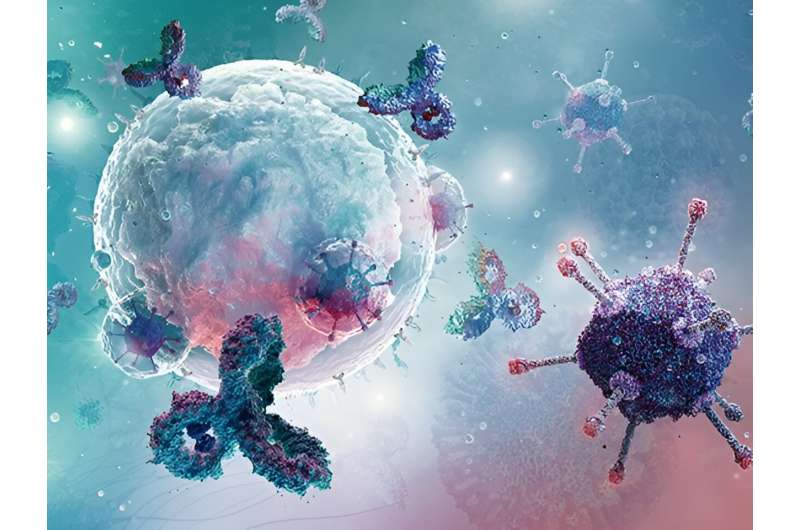This article has been reviewed according to Science X's editorial process and policies. Editors have highlighted the following attributes while ensuring the content's credibility:
fact-checked
peer-reviewed publication
trusted source
proofread
Flu research: Interferon-gamma from T follicular helper cells is required to create lung-resident memory B cells

During a bout of influenza, B cells interact with other immune cells and then take different paths to defend the body. One path is the B cells that differentiate into antibody producing cells. Another path is the B cells that differentiate into lung-resident memory B cells, or lung-BRMs, that are critical for pulmonary immunity.
Unlike antibody-producing B cells that help fight the current infection, the long-lived, non-circulating lung-BRMs migrate to the lungs from draining lymph nodes. They reside there permanently and lie in wait as the first layer of defense that can quickly react to produce antibodies in a future infection.
Understanding the mechanism that creates these lung-BRMs is important for better flu vaccine development. Seasonal influenza kills 290,000 to 650,000 people each year, according to the World Health Organization. Yet flu vaccines are less effective in the elderly—the most at-risk population—compared to younger people. Also, there is need for vaccines that are more effective against later variants of a particular virus.
André Ballesteros-Tato, Ph.D., and colleagues at the University of Alabama at Birmingham have now published a mouse-model study in the journal Immunity showing that interferon-gamma produced by T follicular helper cells, or Tfh cells, after intranasal influenza infection is required to initiate the path of B cell differentiation into lung-BRMs. Ballesteros-Tato is an associate professor in the UAB Department of Medicine Division of Clinical Immunology and Rheumatology
During influenza infection, both Tfh and B cells are present at germinal centers in the lymph nodes that drain the lungs. Class-switched memory B cells that are primed against the influenza virus begin to appear in the lungs at day 10 of the infection, and their numbers peak at Day 30. However, the UAB researchers found that, if mice were deficient in Tfh cells, or if the Tfh cells were blocked by an antibody, the lung-BRMs did not accumulate. Thus, Tfh cell help is required for class-switched-specific BRM responses to influenza.
What role do the Tfh cells play?
The UAB researchers found that the preferential differentiation of lung-BRMs early after infection correlated with differences in the Tfh cell response early in the viral infection. They found that the number of Tfh cells increased quickly and peaked between days 10 and 15. By Day 10, early in the flu infection, nearly 40 percent of the Tfh cells were producing interferon-gamma, or INF-γ; but that frequency dropped sharply thereafter.
The production of INF-γ by Tfh cells turned out to be key to the lung-BRM response in flu. Ballesteros-Tato and colleagues found that mice whose Tfh cells were unable to produce INF-γ had a dramatically reduced frequency and number of influenza-specific BRMs in the lungs. Furthermore, the absence of INF-γ-producing Tfh cells, and therefore fewer lung-BRMs, was shown to compromise immune protection when mice were later reinfected with a different strain of influenza.
The researchers asked whether the requirement for IFN-γ signaling in lung-BRM development was intrinsic to B cells, meaning the interferon was producing effects inside the B cells. They found that mice whose B cells lacked the receptor for INF-γ had significantly diminished numbers of flu-specific BRMs after influenza virus infection. Inside B cells, the transcription factor STAT1 is known to be required for optimal INF-γ signaling. The researchers found that mice whose B cells lacked STAT1 also failed to accumulate flu-specific BRMs after influenza infection.
In mechanistic details, the researchers found that intrinsic IFN-γ-STAT1 signaling in B cells in the germinal center of lung-draining lymph nodes promoted expression of the T-bet transcription factor, and T-bet was necessary for differentiation into pre-memory B cells that express the surface marker CXCR3. Subsequently, CXCR3+ pre-memory B cells differentiated into CXCR3+ memory B cells, which exited the mediastinal lymph nodes and homed to the lung to become lung-BRMs.
"In this proposed model, CXCR3+ memory B cells in the mediastinal lymph nodes are the precursors of lung-BRMs," said Ballesteros-Tato. "Our data provide evidence of a critical role for IFN-γ-producing Tfh cells in generating lung-BRM responses and provide new insights into the mechanisms that fine-tune germinal center B cell fate decisions after influenza virus infection."
"This knowledge is essential for designing new vaccine strategies tailored to elicit potent lung-BRM responses, which have the potential to generate enhanced cross-protection to escape variants."
More information: Nicole M. Arroyo-Díaz et al, Interferon-γ production by Tfh cells is required for CXCR3+ pre-memory B cell differentiation and subsequent lung-resident memory B cell responses, Immunity (2023). DOI: 10.1016/j.immuni.2023.08.015


















